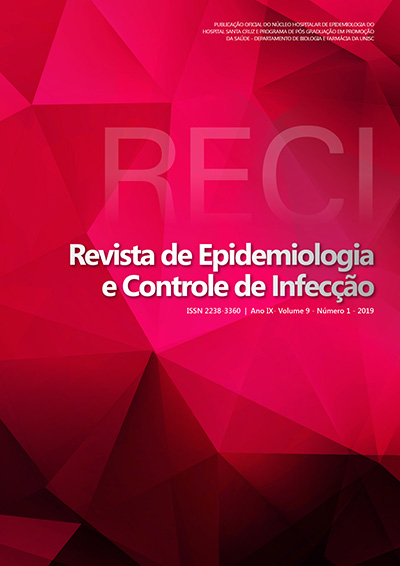Evolution of bacterial resistance in community-acquired urinary tract infection in the elderly
DOI:
https://doi.org/10.17058/reci.v9i1.10468Abstract
Background and objectives: Urinary tract infections of community origin in the elderly are frequent. The study aimed to evaluate the prevalence and evolution of resistance of gram-negative bacteria to community-acquired urinary tract infection in the elderly. Methods: Cross-sectional study, divided into two periods 2011-2012 and 2013-2015, carried out in the municipality of Goiânia, Goiás, Brazil from 2011 to 2015, with the participation of four clinical laboratories. All positive uroculture reports with the respective antibiogram were considered. Only the first report of each patient was included in the analysis, unless reinfection occurred three months after the first. Results: A total of 3,388 antibiograms were analyzed. The most frequently isolated microorganisms were successively E. coli (75.6%), K. pneumoniae, (16.6%) and Proteus spp. (5.7%). E. coli showed a high resistance rate for Sulfonamide (40.5%), Ciprofloxacin (35.0%) and increased resistance to 2nd Generation Cephalosporins (p = 0.007). The highest resistance rates in K. pneumonia were to Sulfonamide (35.2%), Nitrofurantoin (37.9%), Gemifloxacin (46.1%) and Ofloxacin (46.1%) with Increase in resistance evolution to Carbapenems (p = 0.03) and Cephalosporins of the 1st Generation (p = 0.049). For Proteus spp., the highest resistance were to Gemifloxacin (46.11%), Ofloxacin (46.11%), Nitrofurantoin (76.68%) and Levofloxacin (81.87%). Enterobacter spp., had greater resistance to Gemifloxacin (42.9%), Ofloxacin (42.9%), 1st Generation Cephalosporins (44.3%) and Levofloxacin (77.1%), with evolution of resistance to 2nd Generation Cephalosporin (p = 0.0057). Conclusion: The prevalence of bacterial resistance was high for the main antimicrobials tested and a trend was identified for the increase of resistance among the analyzed microorganisms. KEYWORDS: Bacterial Infections. Enterobacteriaceae Infections. Anti-Infective Agents. Urinary tract. Escherichia coli.Downloads
Downloads
Published
How to Cite
Issue
Section
License
The author must state that the paper is original (has not been published previously), not infringing any copyright or other ownership right involving third parties. Once the paper is submitted, the Journal reserves the right to make normative changes, such as spelling and grammar, in order to maintain the language standard, but respecting the author’s style. The published papers become ownership of RECI, considering that all the opinions expressed by the authors are their responsibility. Because we are an open access journal, we allow free use of articles in educational and scientific applications provided the source is cited under the Creative Commons CC-BY license.


